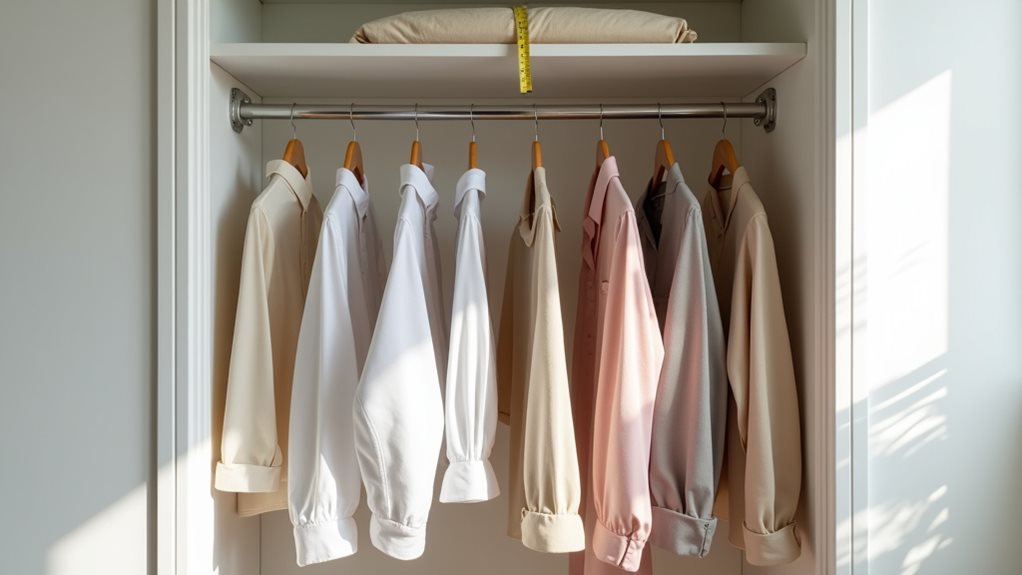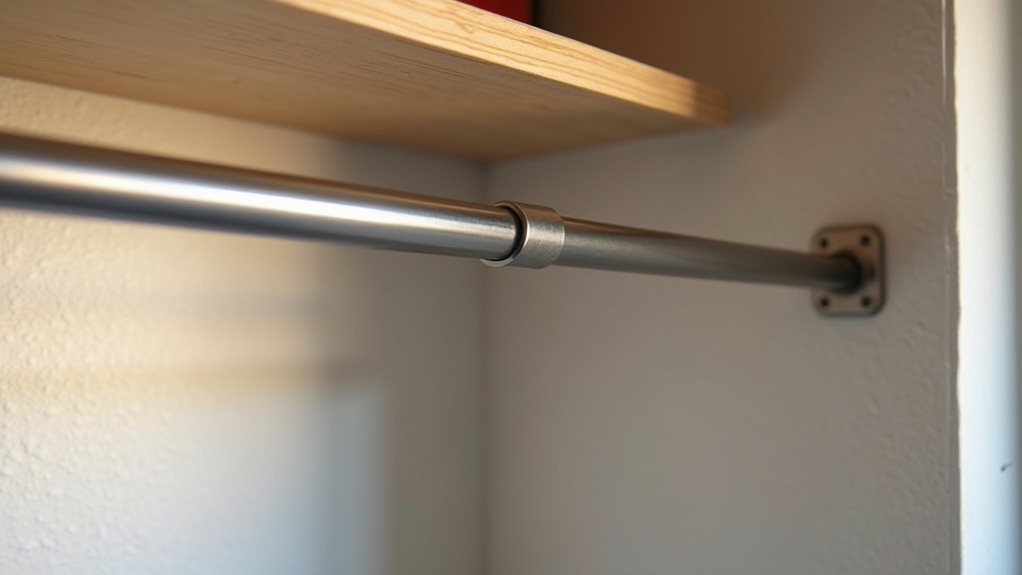You should mount a single closet rod about 66–68 inches off the finished floor for everyday clothing, positioning it roughly 12 inches from the back wall so hangers clear the wall and move freely. For a double-rod setup, place the upper rod near 80 inches and the lower rod around 40–42 inches to maximize usable space for shirts above and pants or skirts below. For long coats use about 72–80 inches; more tips follow.
TLDR
- Standard single closet rod: mount 66–68 inches from the finished floor for everyday clothing.
- For double-rod systems, place the upper rod about 76–82 inches and the lower rod near 40–42 inches.
- Leave roughly 36–40 inches of vertical clearance between rods to accommodate shirts and folded pants.
- Set long-garment or coat rods at least 72 inches high (up to 80–82 inches) to prevent hems from touching the floor.
- Mount rods about 12 inches from the back wall, anchored into studs or heavy-duty anchors for secure hanger movement.
Standard Single Rod Heights for Everyday Clothing

A well-placed closet rod makes daily dressing easier, and for most homes a single rod set between 66 and 68 inches from the finished floor will accommodate the bulk of everyday clothing without garments touching the floor. You should mount the rod about 12 inches from the back wall, anchor it securely into studs, and consider 66–68 inches as a versatile baseline, adjusting for taller garments. Additionally, maintaining a gap of 1-2 inches from the wall allows for optimal hanger movement and prevents wrinkling.
Best Heights for Double Rod Systems and Maximizing Space
Set your upper rod around 76–80 inches to give you room for shirts and blouses, while placing the lower rod near 38–40 inches to handle pants and skirts without dragging. Tension rods can be a great option if you want to avoid drilling and need an adjustable solution for your closet. Keep at least 36–40 inches of vertical clearance between rods when possible, or adjust to 42/84 inches if you need to accommodate longer garments, and make sure the rod sits about 12 inches out from the back wall to prevent bunching. For best results, position rods based on the user height who will use the closet most so items are reachable and organized.
Upper Rod Height
Because you’ll generally be maximizing vertical space in a double-rod closet, positioning the upper rod around 76 to 82 inches from the floor offers the best balance between reachability and storage capacity.
Aim near 80 inches to fit shirts and blouses, preserve shelf space above, and keep hangers clear; secure brackets into studs, allow clearance under shelves, and consider adjustability for diverse users.
Lower Rod Placement
Think through lower rod placement as the backbone of a double-rod closet, since getting that height right lets you stack two usable hanging zones without wasting vertical space or creating interference between garments.
Aim for about 40–42 inches (40½ ideal) for pants and skirts, adjust 38–42 as needed, leave 2 inches below shelves, make certain 41 inches clearance between rods, and mount securely for stability.
Rod Spacing Tips
Lower rod placement sets the foundation for a double-rod layout, and now you’ll want to fine-tune the spacing between rods to maximize usable hanging area without creating clearance headaches.
Aim for about 36 inches between rod centers—upper near 80–82 inches, lower around 40–41—increase lower to 30–40 inches for kids, keep 2–3 inches above shelves, and allow 18–24 inches depth.
Recommended Rod Placement for Children’s Closets
When planning rod placement for a child’s closet, consider age-based heights—roughly 30–40 inches for toddlers and about 36–40 inches for young children, with an option for a lower rod around 40 inches in double-rod systems for older kids. You’ll want adjustable or modular hardware so you can raise the rod as your child grows, providing long-term usability without major remodeling. Prioritize secure mounting, appropriate projection from the back wall, and reachable clearance so children can access clothing safely and independently. Additionally, using furring strips can help create a more organized and efficient closet space by allowing for better shelving and rod installation.
Age-Based Rod Heights
Typically, you’ll want to set closet rods for children lower than adult standards so garments are within easy reach and the space stays functional as they grow; for toddlers and preschoolers that means a single rod about 30–40 inches off the floor to support small shirts, dresses and pants, while early elementary-age kids often do well with a lower rod near 30 inches plus an optional upper rod at 60–66 inches to accommodate future growth.
For tweens, place a lower rod near 40 inches and an upper rod 66–80 inches, adding center support for long spans; teenagers typically use adult heights, around 66 inches for single rods or 72–80 inches for upper rods, while maintaining a 12-inch depth to avoid wrinkles.
Adjustable Growth Solutions
Think ahead and set up an adjustable rod system that grows with your child, because flexible hardware and modular components let you reconfigure hanging levels, shelving, and accessories without a full remodel.
Install tool-free adjustable rods and double-hang options, place a lower rod around 36–40 inches, reserve upper positions near 60–72 inches, and use durable materials plus movable shelves and bins for efficient, long-term storage.
Safety and Accessibility
Because safety and accessibility go hand in hand in children’s closets, you should place rods at heights that match your child’s size and abilities while using secure hardware and clear spacing rules to prevent accidents.
Install lower rods around 30–40 inches for toddlers, allow preteens up to 48 inches, consider double rods (40/80 inches), use rounded edges, solid anchors, and 12-inch depth for safe, ergonomic access.
Where to Mount Rods for Long Garments and Coats
When you’re mounting a rod for long garments and coats, place it high enough to keep hems from touching the floor while still remaining reachable, generally aiming for a minimum of about 72 inches from the floor for most dresses and coats; many installations use 66–68 inches as a compromise between accessibility and clearance, while single-rod setups can go as high as 80–82 inches when vertical space allows and users are comfortable using a step stool.
Mount into studs or use heavy-duty anchors, measure longest garments plus hanger thickness, and adjust for user reach to prevent dragging or excessive stretching.
Ideal Rod Depth and Spacing From the Wall

Get your measurements right and you’ll avoid crowded hangers and wrinkled clothes: ideal rod depth is typically about 12 inches from the back wall, which gives average garments enough room to hang freely without pressing against the closet back, while deeper closets (around 24 inches) let you increase that depth for bulkier coats or padded hangers.
Place rods 12–18 inches from side walls, mark precisely.
Adjustable and Custom Rod Solutions for Different Households
If you need flexibility in your closet layout, adjustable and custom rod systems give you practical ways to tailor storage to your household’s height, wardrobe mix, and available space.
You can mount wooden cleats or brackets, use telescoping or tension rods, add middle supports for long spans, and set double or multi-level rods for mixed heights, choosing materials and weight ratings to suit garment types and load.
Final Note
You’ll want to mount closet rods so they fit how you actually live: standard single rods at about 66–68 inches suit most adults, double-rod systems with top at 80–84 inches and bottom at 40–44 inches increase capacity, and lower heights for children keep clothes reachable. Reserve higher, uninterrupted runs for long coats, allow 24 inches depth and 1–2 inches from the wall, and consider adjustable or custom solutions to adapt as needs change.